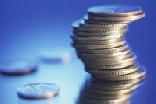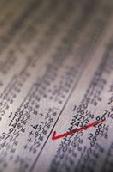
 |
|
| Financial Terms | |
| Residual assets |
|
Information about financial, finance, business, accounting, payroll, inventory, investment, money, inventory control, stock trading, financial advisor, tax advisor, credit.
Main Page: finance, financial, inventory control, payroll, credit, investment, tax advisor, financial advisor, Also see related: first time homebuyer, home financing, mortgage, insurance, home, financing, condo, buy home, homebuying, |
Definition of Residual assets
Residual assetsassets that remain after sufficient assets are dedicated to meet all senior debtholder's claims in full.
Related Terms:Acquisition of assetsA merger or consolidation in which an acquirer purchases the selling firm's assets. AssetsA firm's productive resources. Assets requirementsA common element of a financial plan that describes projected capital spending and the Current assetsValue of cash, accounts receivable, inventories, marketable securities and other assets that Exchange of assetsAcquisition of another company by purchase of its assets in exchange for cash or stock. Financial assetsClaims on real assets. Long-term assetsValue of property, equipment and other capital assets minus the depreciation. This is an  Net assetsThe difference between total assets on the one hand and current liabilities and noncapitalized longterm Non-reproducible assetsA tangible asset with unique physical properties, like a parcel of land, a mine, or a Other current assetsValue of non-cash assets, including prepaid expenses and accounts receivable, due Publicly traded assetsassets that can be traded in a public market, such as the stock market. Quick assetsCurrent assets minus inventories. Real assetsIdentifiable assets, such as buildings, equipment, patents, and trademarks, as distinguished from a Reproducible assetsA tangible asset with physical properties that can be reproduced, such as a building or Residuals1) Parts of stock returns not explained by the explanatory variable (the market-index return). They Residual claimRelated: equity claim  Residual dividend approachAn approach that suggests that a firm pay dividends if and only if acceptable Residual lossesLost wealth of the shareholders due to divergent behavior of the managers. Residual methodA method of allocating the purchase price for the acquisition of another firm among the Residual riskRelated: unsystematic risk Residual valueUsually refers to the value of a lessor's property at the time the lease expires. Return on assets (ROA)Indicator of profitability. Determined by dividing net income for the past 12 months Return on total assetsThe ratio of earnings available to common stockholders to total assets. ASSETSAnything of value that a company owns. Current assetsCash, things that will be converted into cash within a year (such as accounts receivable), and inventory. RATE OF RETURN ON TOTAL ASSETSThe percentage return or profit that management made on each dollar of assets. The formula is: AssetsThings that the business owns.  Current assetsAmounts receivable by the business within a period of 12 months, including bank, debtors, inventory and prepayments. Fixed assetsThings that the business owns and are part of the business infrastructure – fixed assets may be Intangible fixed assetsNon-physical assets, e.g. customer goodwill or intellectual property (patents and trademarks). Residual income (RI)The profit remaining after deducting from profit a notional cost of capital on the investment in a business or division of a business. Tangible fixed assetsPhysical assets that can be seen and touched, e.g. buildings, machinery, vehicles, computers etc. AssetsItems owned by the company or expenses that have been paid for but have not been used up. Intangible assetsassets owned by the company that do not possess physical substance; they usually take the form of rights and privileges such as patents, copyrights, and franchises. current assetsCurrent refers to cash and those assets that will be turned fixed assetsAn informal term that refers to the variety of long-term operating return on assets (ROA)Although there is no single uniform practice for Fixed Assets Turnover RatioA measure of the utilization of a company's fixed assets to Residual ValueThe value attributed to a company to represent all future cash flows Return on Total Assets RatioA measure of the percentage return earned on the value of the Total Debt to Total Assets RatioSee debt ratio residual incomethe profit earned by a responsibility center that exceeds an amount "charged" for funds committed to that center Other assetsA cluster of accounts that are listed after fixed assets on the balance sheet, financial assetsClaims to the income generated by real assets. Also called securities. real assetsassets used to produce goods and services. residual incomeAlso called economic value added. Profit minus cost of capital employed. Preferred Stock Stock that has a claim on assets and dividends of a corporation that are priorto that of common stock. Preferred stock typically does not carry the right to vote. Realizable Revenue A revenue transaction where assets received in exchange for goods andservices are readily convertible into known amounts of cash or claims to cash. Current AssetsCash and other company assets that can be readily turned into cash within one year. Fixed AssetsLand, buildings, plant, equipment, and other assets acquired for carrying on the business of a company with a life exceeding one year. Normally expressed in financial accounts at cost, less accumulated depreciation. Longer-Term Fixed Assetsassets having a useful life greater than one year but the duration of the 'long term' will vary with the context in which the term is applied. Personal Assetsassets, the title of which are held personally rather than in the name of some other legal entity. Residual ValueTypically estimated based on the present value of the after-tax cash flows expected to be earned after the forecast period. Other capitalIn the balance of payments, other capital is a residual category that groups all the capital Stockholder's equityThe residual claims that stockholders have against a firm's assets, calculated by Change in Accounting EstimateA change in accounting that occurs as the result of new information Shareholders' EquityThe residual interest or owners' claims on the assets of a corporation Related to : financial, finance, business, accounting, payroll, inventory, investment, money, inventory control, stock trading, financial advisor, tax advisor, credit. |